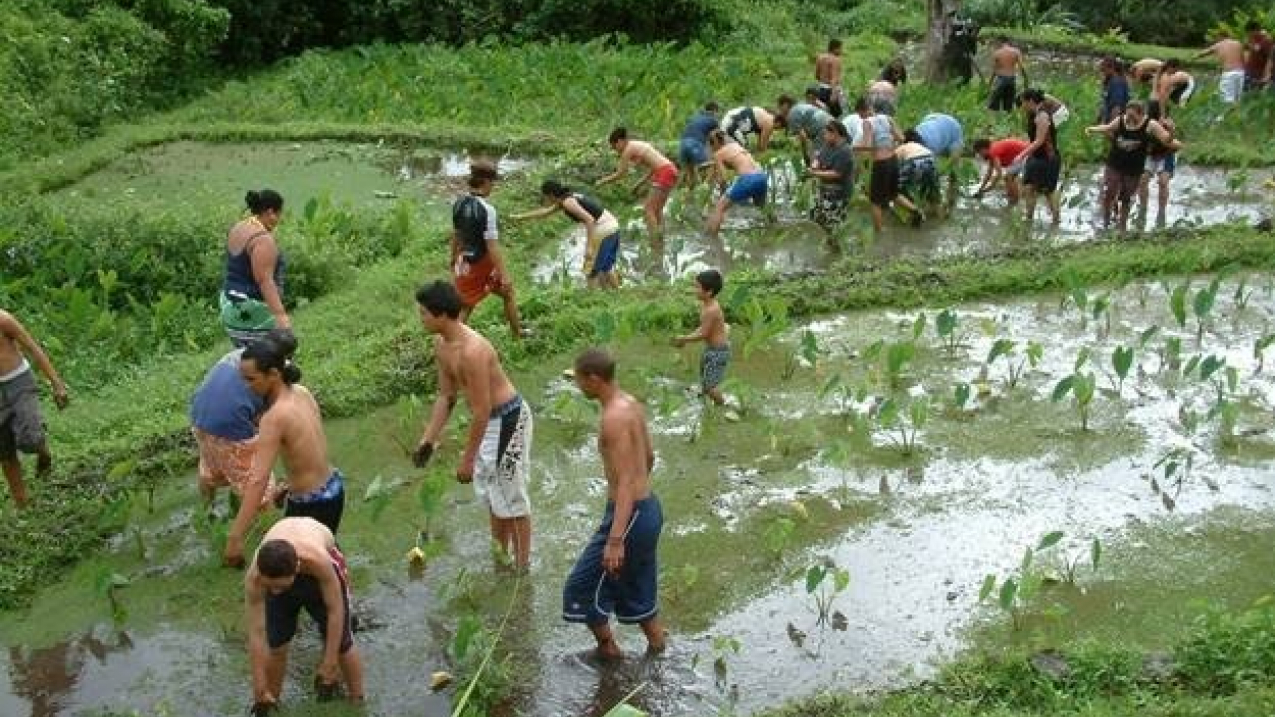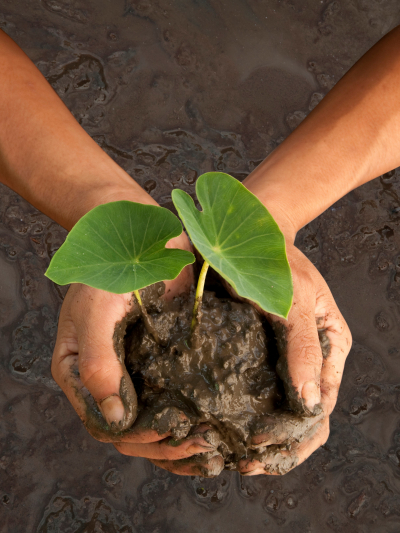Learning science by connecting to our ahupuaʻa
From the top of the mountains to the open sea, the ahupuaʻa is a land division where culturally-based knowledge and practices are used to manage the natural resources that a community needs to thrive. This self-sustaining system attributed to the success of the Hawaiian people for centuries because they understand that actions upstream affect the living environment downstream.

High school students weed the loʻi (wet taro patch) doing habitat restoration, while also connecting to their ahupuaʻa. (Image credit: Molokaʻi High School)
ʻŌlelo noʻeau (Hawaiian proverbs or wise sayings):
He aliʻi ka ʻāina; he kauwa ke kanaka The land is the chief; man is its servantThis traditional Hawaiian relationship between humans and their surroundings provides a powerful tool to balance environmental, social, and economic development needs. This approach is still applied in today's contemporary society affording opportunities to integrate both traditional and modern methods of resource management.
The Hawaiʻi Bay Watershed Education and Training (B-WET) program acknowledges these traditions by supporting locally relevant Meaningful Watershed Educational Experiences (MWEEs) for students, teachers, and communities in numerous ahupuaʻa statewide. Located on the island of Oʻahu, Heʻeia is an ahupuaʻa where multiple B-WET projects have been implemented for several years. These outside spaces of knowledge and culture provide learning avenues for students to engage with their watershed.
Historically, the Heʻeia ahupuaʻa supported upland agriculture that complemented downstream aquaculture and served as a source of food security for the community. However, most of the practices that kept this area productive faded over time. In fact, from the 1950s to the 1990s, invasive grasses and mangroves covered the 1.5 mile long fishpond wall and ancient irrigation ditches (ʻauwai) that fed the taro patches. In the early 2000s, youth leaders started to partner with community elders (kūpuna) to restore the ahupuaʻa. Today, there are acres of taro patches in the uplands that connect down to a historical fishpond. These places are working, living laboratories that incorporate strong cultural and community ties. Due to the significance of Heʻeia as a location where traditional Hawaiian land management can be studied, Heʻeia was designated as a National Estuarine Research Reserve offsite link (NERR) monitored by the Hawaiʻi Institute of Marine Biology offsite link in partnership with NOAA and the surrounding community.
Ma ka hana ka ʻike In working one learnsRain that falls on the mountains flows down to Kākoʻo ʻŌiwi offsite link where wet taro patches (loʻi) provide traditional food farming, as well as natural filtration in the uplands (ma uka). Stream water is redirected into the loʻi where the water slows down and sediment settles, then the clean water returns to the stream and continues down towards the sea (ma kai). Students get the opportunity to see how water quality changes throughout the ahupuaʻa and how modifying the environment can impact that quality.
He waiwai nui ka lōkahi Unity is a precious possession
Moving down the ahupuaʻa, the stream ends, and feeds directly into the sea (kai) between Heʻeia State Park offsite link and Heʻeia fishpond. The stream is ideal for monitoring activities to understand how actions on the land impact the ocean. Various technology is built into this project, such as remote sensing and mapping with drones. Students expand on their cultural knowledge, build on their curiosity, and learn modern methods of data collection. All of this reinforces the connection between traditional and modern science.
Hewa i ka wai Great as a body of water A great multitude of so many, that one cannot count
Our journey down the ahupuaʻa ends at Paepae o Heʻeia offsite link, an organization that practices traditional Hawaiian methods of aquaculture and is dedicated to mālama (care for) an 88-acre historical fishpond (loko iʻa). With help and support from the community, invasive mangrove was removed to allow the natural environment to flourish. The fishpond wall was repaired, and the amount of sedimentation in the fishpond and surrounding waterways were reduced. Work continues to be done in this large scale effort to improve the ecosystem and create a healthy environment for native species.
ʻAʻohe pau ka ʻike i ka hālau hoʻokahi All knowledge is not learned in one school
The opportunity to engage with the local environment and actively mālama ʻāina (take care of the land) provides students from various backgrounds that face education barriers the chance to get out of a traditional classroom and get outside. These experiences give them a sense of stewardship for the place they call home and adds relevance to academic subjects they study in school. Participating in B-WET can change their attitude about education and inspire them to move on to higher education. Furthermore, this connection to a living classroom can lead students to explore new pathways and career opportunities in STEM (science, technology, engineering, and mathematics).
Heʻeia continues to be one of many successful ahupuaʻa in Hawaiʻi where learners of all ages can connect with their local environment. Through the collaboration of schools and community organizations statewide, NOAA B-WET supports MWEEs where students understand the importance of both traditional and modern science. Engaged students can facilitate more insightful resource management and informed decision making, which are key to protecting the islands for future generations.
I ulu no ka lala i ke kumu The branches grow because of the trunk Without our ancestors, we would not be here
Mahalo
We would first like to show appreciation for the ʻāina (land), kai (sea), and ahupuaʻa of Heʻeia. Mahalo (thanks) to our community partners for being environmental leaders, sharing your knowledge, and growing the next generation of stewards. These projects and learning opportunities were made possible with the support from our contributors: NOAA, the National Marine Sanctuary Foundation offsite link, and the North American Association for Environmental Education offsite link. The videos were filmed, beautifully compiled, and edited by Great Lakes Outreach Media offsite link. Finally, mahalo to our participants who will carry on the kuleana (responsibility) and perpetuate aloha ʻāina (loving the land).
Ua ao Hawaiʻi ke ʻōlino nei mālamalama Hawaiʻi is enlightened for the brightness of day is here Hawaiʻi is in an era of education
To learn more about the ʻōlelo noʻeau (Hawaiian proverbs or wise sayings) shared in this story, please see the following publication: Pukui, M. K., & Varez, D. (1983). ʻŌlelo Noʻeau: Hawaiian proverbs & poetical sayings. Honolulu, Hawaiʻi: Bishop Museum Press.
To learn more about the taro plant and its cultural significance in Hawaiʻi, you can visit the following webpages from the National Park Service and Mānoa Heritage Center offsite link (a B-WET grantee).

